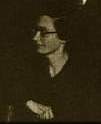Claude Arrieu facts for kids
Claude Arrieu (born Louise-Marie Simon, 1903–1990) was a very active French composer. She wrote many different kinds of music.
Her Life and Music
Claude Arrieu was born in Paris, France. She started learning music at a young age. Her mother, Cecile Paul Simon, was also a composer.
Claude loved the music of famous composers like Bach and Mozart. Later, she also liked Igor Stravinsky. But the composers who inspired her most were Gabriel Fauré, Claude Debussy, and Maurice Ravel.
Arrieu dreamed of becoming a top musician. In 1924, she joined the Conservatoire de Paris, a famous music school. She studied piano with Marguerite Long and learned from other great teachers like Paul Dukas. In 1932, she won first prize for her musical compositions.
After this, she developed her own special way of writing music. She was very interested in how music changed over time. She also liked trying new musical techniques.
In 1935, she started working for French Radio. She helped create many different radio shows until 1947. She even worked on an experimental radio series called La Coquille à planètes. In 1949, she won an award called the Prix Italia for her music score Frédéric Général.
Claude Arrieu wrote music for almost everything! She composed "pure music" for concerts. She also wrote music for theatre plays, films, radio shows, and even music hall performances. She was known for her love of rhythm and creating vivid musical pictures. Her music was often easy to listen to and had a clear, elegant structure. People often described her music as lively, clear, and full of natural melody.
She wrote many concertos, which are pieces for a solo instrument with an orchestra. These included concertos for piano, violin, flute, and trumpet. She also wrote pieces like Petite suite en cinq parties (1945) and "Concerto for wind quintet and strings" (1962).
Her chamber music pieces are also important. These are for small groups of instruments. Some examples are her Trio for Woodwinds (1936) and Clarinet Quartet (1964). Her Sonatine for flute and piano became very popular after its first radio performance in 1944.
While her instrumental music was a big part of her career, Claude Arrieu was especially known for her vocal music. She loved setting poems to music. She used poems by famous writers like Joachim du Bellay and Paul Éluard. Some of her vocal works include Chansons bas (1937) and À la Libération, a cantata about love during wartime.
Arrieu also wrote opéra bouffe, which are funny operas. Her first one, Cadet Roussel, was performed in 1953. Another opera, La Princesse de Babylone (1960), was praised for its unique songs and exciting show.
She composed music for many films too. Some of her film scores include Les Gueux au paradis (1946) and Niok l'éléphant (1957). She also wrote music for television, like Julie Charles (1974).
Pierre Schaeffer, a famous French composer, said that Claude Arrieu was a composer who was very much a part of her time. He noted her strong presence and ability to create emotion with excellent technique. She always found a way to touch people's hearts with her music.
Selected Works
Claude Arrieu wrote many pieces for the stage and radio. Here are a few:
- Noé (1931–1934) – A musical story performed in Strasbourg in 1950.
- Cadet Roussel (1938–1939) – A funny opera first performed in Marseilles in 1953.
- La Coquille à planètes (1944) – A radio opera.
- La princesse de Babylone (1953–1955) – Another funny opera, performed in Rheims in 1960.
- Cymbeline (1958–1963) – An opera based on Shakespeare's play.
Other Compositions
- Trio d'anches / Wind Trio (1936)
This piece is for three wind instruments: oboe, clarinet, and bassoon. Arrieu wrote it for a group called the Trio D’Anches de Paris. The music shares parts equally between the instruments. The first part is a lively, mock march. The second part is gentle and swaying, then becomes faster and playful. The last part is also like a march, but with a gentle ending.
- Wind Dixtuor (1967)
This piece is for ten wind instruments, including flutes, clarinets, and trumpets. The first part has a humorous feel. The second part is calm with a short, playful section in the middle. The third part starts peacefully, then becomes busy and playful. The music is very expressive for the wind instruments and ends with a surprisingly soft touch.
See also
 In Spanish: Claude Arrieu para niños
In Spanish: Claude Arrieu para niños


